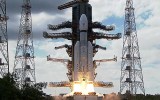
India has made lunar history after landing a budget spacecraft on the moon’s unexplored south pole, the same week in which Russia’s mission failed.
Indian Prime Minister hailed it as an “unforgettable” and “phenomenal” moment for the country and a “victory cry for new India”.
Scientists and officials clapped, cheered and hugged each other as the Chandrayaan-3 spacecraft landed.
Across India, people broke out in celebration, setting off firecrackers and dancing in the streets.
Nearly seven million watched the YouTube live stream.
“India is on the moon,” said S Somanath, chief of the Indian Space Research Organisation (ISRO).
The Chandrayaan-3 was launched with a budget of about 6.15 billion rupees ($114 million), less than the cost to produce the 2013 Hollywood space thriller Gravity.
India is now the fourth country to successfully land a spacecraft on the moon after the United States, China and Russia, but the first to land at the south pole.

Rough terrain makes a south pole landing difficult, and a first landing is historic.
The moon’s southern extreme appears to be covered in frozen water which could supply fuel, oxygen and drinking water for future missions.
“Landing on the south pole would actually allow India to explore if there is water ice on the moon,” said Carla Filotico, a partner and managing director at consultancy SpaceTec Partners.
This was India’s second attempt to land a spacecraft on the moon and comes less than a week after Russia’s Luna-25 mission failed.
Chandrayaan means “moon vehicle” in Hindi and Sanskrit.
In 2019, ISRO’s Chandrayaan-2 mission successfully deployed an orbiter but its lander crashed.
Russia’s space agency Roskosmos congratulated India on the landing.
“Roskosmos congratulates Indian colleagues on the successful landing of the Chandrayaan-3 spacecraft,” it said in a post on its Telegram channel.
“Exploration of the moon is important for all mankind. In the future it may become a platform for deep space exploration.”
The Chandrayaan-3 is expected to remain functional for two weeks, running a series of experiments including a spectrometer analysis of the mineral composition of the lunar surface.
The moon rover will take a few hours or a day to come out of the spacecraft, Somanath told reporters, adding that the landing has given India confidence to extend its reach to possible voyages to Mars and Venus.
India is also planning to launch a mission in September to study the sun, Somanath said.
A human space flight is also planned and, while no official date has been announced, preparations are likely to be ready by 2024.
The landing is expected to boost India’s reputation for cost-competitive space engineering.










